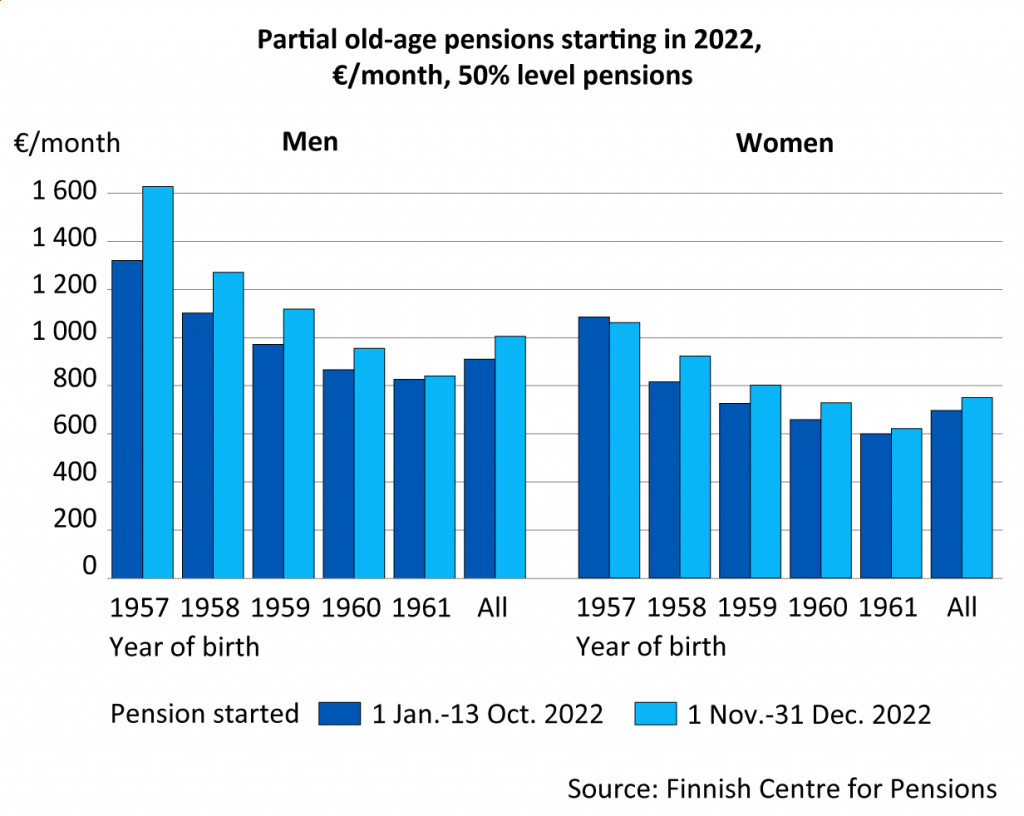The well-off found the partial old-age pension in 2022

Last year, nearly 35,000 persons drew the partial old-age pension for the first time. This is more than ever before. A substantial number of well-off people chose to start drawing a partial old-age pension last year. As a rule, the pension is drawn at a 50-per-cent level, which translates into an average of 830 euros per month.
According to recent statistics of the Finnish Centre for Pensions, the year 2022 was record-breaking for the partial old-age pension. Nearly 35,000 new partial old-age pensions were drawn in 2022. This is 2.5 times more than in previous years. At the same time, the average age of the recipients of this pension benefit rose as particularly those approaching their retirement age were eager to claim the partial old-age pension. On average, the recipients were 62.4 years old.
The main reason underlying the steep rise in the number of partial old-age pension recipients was the exceptional index development. Those planning to retire on a full old-age pension in early 2023 benefitted from taking out the early old-age pension already in 2022.
“Many Finns approaching their retirement age calculated that the brisk rise in the earnings-related pension index at the turn of the year would clearly increase the amount of the partial old-age pension. As a result, a full old-age pension beginning in early 2023 would be higher than if the person had not withdrawn a partial old-age pension at the end of 2022”, Development Manager Jari Kannisto (Finnish Centre for Pensions) explains.
Higher-than-average pensions at year-end 2022
The partial old-age pension, introduced in connection with the 2017 pension reform, has been rather popular. The exceptional situation in 2022 is emphasized by the fact that many of those taking a partial old-age pension had a higher-than-average pension.
“The partial old-age pension was clearly higher among those who took out the pension at year-end 2022. The difference in pension amount is also reflected in an age cohort specific analysis. In addition, many of those choosing to take out the partial old-age pension towards the end of 2022 were well off, with a pension that clearly exceeded the average partial old-age pension level,” Kannisto points out.

A person taking out a partial old-age pension can withdraw either half or one quarter of the pension they have earned so far. In 2022, circa four out of five partial old-age pensions were of the 50% level, averaging 830 euros per month.
The partial old-age pension can be draw as of age 61. Typically, about one in ten people aged 61 will choose this pension benefit. In 2022, as many as one in six opted for this possibility.
“On average, they have three years and six months left to their retirement age. Taking out the partial old-age pension at the 50% level means an average reduction of 150 euros per month in their pension”, Kannisto calculates.
Majority of partial old-age pensioners continue working
When the part-time pension was replaced by the partial old-age pension, the aim of the legislators was for the new pension benefit to encourage Finns to continue working while drawing a pension.
Around four out of five people drawing the partial old-age pension at a 50% level in 2022 were working before drawing the pension. The figure was even higher for those who drew the pension at a 25% level. Most of them continued working while drawing the pension.
“Of those who drew the 50% pension, more than 70 per cent continued working. Nearly 90 per cent of those who drew the 25% pension continued working. Those claiming the pension at the end of the year were primarily working. Compared to the previous year, this clearly increased the share of persons continuing at work after drawing the pension.
The average earnings of those opting for a partial old-age pension before taking the pension are not significantly different from the average earnings of other wage earners of the same age.
Years-of-service pension – a benefit for the few
In connection with the 2017 pension reform, the years-of-service pension was also introduced. Very few have claimed and been granted this benefit. In 2022, a total of 105 men and 14 women received the years-of-service pension.
Two out of four years-of-service pensions were granted based on musculoskeletal diseases. This share has increased.
Persons retiring on a years-of-service pension have a long work history. In 2022, the average pension insured work history of new pensioners on a years-of-service pension spanned an ample 39 years.
At the end of 2022, the average monthly years-of-service pension was 2,150 euros.
Partial old-age pension
- replaced the part-time pension in the 2017 pension reform;
- offers the possibility of persons aged 61 or more to take out 25% or 50% of the pension they have earned so far;
- permanently reduces the pension by 0.4% for each month that the pension is taken out early, before reaching the retirement age;
- can be taken out late, after reaching the retirement age. If it is taken late, after reaching one’s retirement age, the share taken out is increased by 0.4% for each month that the pension is deferred;
- does not limit how much a person can work or earn; can be drawn by persons who are unemployed or working.
Years-of-service pension
- can be granted to workers aged 63 or more before the old-age pension;
- can be granted to persons who have done work that requires great mental or physical effort for at least 38 years;
- requires a medical statement that the worker’s ability to work has been reduced;
- is the pension amount earned up to the time that the benefit is taken out;
- is paid until the recipient reaches their own retirement age.
Read more:
